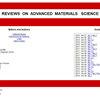合成皮革是室内环境中化学品和异味物质的可能来源
IF 3.9
4区 材料科学
Q2 MATERIALS SCIENCE, MULTIDISCIPLINARY
引用次数: 0
摘要
本文论述了作为软垫家具一部分的合成皮革可能释放到室内环境中的挥发性有机物(VOC)和气味。这项研究的主要任务是对选定的合成皮革进行详细分析,并评估其排放特性,包括气味物质。在温度为 23°C 和相对湿度为 50% 的条件下,采用试验箱法(ČSN EN ISO 16000-9)测定挥发性有机化合物的排放量。排放的化合物被装有 Tenax TA 吸附剂的标准不锈钢管吸附。使用 Sniffer 9000 设备检测气味的特性,该设备直接连接到带有火焰离子化检测器的气相色谱仪。经测试的合成皮革样本释放出的主要物质(浓度最高)包括甲苯(118.2 微克/立方米-3)、1,2-丙二醇(46.2 微克/立方米-3)和柠檬烯(153.0 微克/立方米-3)。在所有评估材料中,俄亥俄州合成皮革产生的对冲色调(-4)最令人不快。本文章由计算机程序翻译,如有差异,请以英文原文为准。
Synthetic leathers as a possible source of chemicals and odorous substances in indoor environment
This article deals with volatile organic substances (VOCs) and odours that can be released into the indoor environment from synthetic leathers that are part of upholstered furniture. The primary task of this study was to provide a detailed analysis of selected synthetic leathers and assess their emission characteristics, including odour substances. VOC emissions were determined using the test chamber method (ČSN EN ISO 16000-9) at a temperature of 23°C and a relative humidity of 50%. The emitted compounds were adsorbed by standard stainless steel tubes with Tenax TA sorbent. VOCs were analysed by thermal desorption and gas chromatography with mass spectrometry The properties of odours were tested using a Sniffer 9000 device, which was directly connected to a gas chromatograph with a flame ionization detector. The dominant substances (with the highest concentration) that were emitted by samples of tested synthetic leathers include toluene (118.2 µg·m−3 ), 1,2-propanediol (46.2 µg·m−3 ), and limonene (153.0 µg·m−3 ). Ohio synthetic leather produced the most unpleasantness hedonic tone (-4) from all evaluated materials.
求助全文
通过发布文献求助,成功后即可免费获取论文全文。
去求助
来源期刊

Reviews on Advanced Materials Science
工程技术-材料科学:综合
CiteScore
5.10
自引率
11.10%
发文量
43
审稿时长
3.5 months
期刊介绍:
Reviews on Advanced Materials Science is a fully peer-reviewed, open access, electronic journal that publishes significant, original and relevant works in the area of theoretical and experimental studies of advanced materials. The journal provides the readers with free, instant, and permanent access to all content worldwide; and the authors with extensive promotion of published articles, long-time preservation, language-correction services, no space constraints and immediate publication.
Reviews on Advanced Materials Science is listed inter alia by Clarivate Analytics (formerly Thomson Reuters) - Current Contents/Physical, Chemical, and Earth Sciences (CC/PC&ES), JCR and SCIE. Our standard policy requires each paper to be reviewed by at least two Referees and the peer-review process is single-blind.
 求助内容:
求助内容: 应助结果提醒方式:
应助结果提醒方式:


